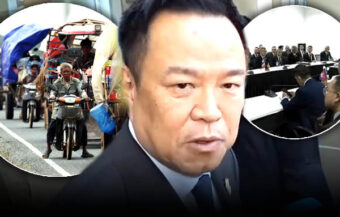The prospects for Thailand if the birth rate continues to decline, are grim. The population, now growing, could fall to 62 million in thirty years. Today, for every aged person there are now five workers, in twenty years it will be less than two. There is hope. Japan’s birthrate has picked up since 2005 and is now close to that of Thailand. In a nation-state such as Thailand, the importance of national zeitgeist, public policy and a discussion on this most serious of issues might help raise awareness of the issue in the minds of the people. That would help do what many naysayers and liberal thinker currently assess as impossible and turn the trend around. For now, in Thailand, the hard facts support the sceptics.
Thailand’s Minister for Higher Education and deputy leader of Palang Pracharat this week announced the next phase of the government’s ongoing policy to promote a higher birth rate. The plan targets young mothers and families on lower-income. The new scheme is in addition to the benefits already in place such as generous tax breaks and other social welfare inducements. It will begin in January 2020. It will see Thai mothers eligible for the scheme, paid ฿3,000 per month for the term of the pregnancy and ฿10,000 towards the birth costs. The government has been criticized by academics for its selective and targeted approach to welfare and its pronatalist policies.

The Thai government has come forward this week to announce further measures aimed at addressing the country’s growing demographic problem and real fears of profound negative consequences for both the Thai economy and society if urgent steps are not taken. Since his first government came to power, it has been a quiet priority for prime minister Prayut Chan-Ocha despite the naysayers in the liberal establishment who say it is simply not possible to turn the declining birth rate around. At the outset, let us admit fairly, that the facts appear to be on their side.
Next phase in Thai government’s incentives to boost birth rate commence in January 2020
The latest social welfare programme will begin in January 2020 and is a Palang Pracharat policy. The manda pracharat is an assortment of social welfare measures that specifically target women in Thailand who are pregnant with children and mothers with young children. The campaign will begin initially by targeting lower-income earners and will cover young children up to the age of six.
Social welfare cardholders initially excluded
However, the new measures will exclude for now those already receiving social welfare benefit cards. The package of measures was presented this week by Suvit Maesincee, a deputy leader of Palang Pracharat who is also the higher education minister in the new government. This new proposal is in addition to existing state benefits which have been upgraded in the last four years to encourage Thai women and their partners to have more children. This package is specifically being targeted at those who are lower earners but also outside the current social welfare card schemes.
Minister Suvit says that government will later broaden the programme to cover more women
The Thai government is working at broadening the manda pracharat programme according to Mr Suvit this week. The ฿3,000 monthly payment and ฿10,000 birth payment are also accompanied by improved child welfare payments up to six years of age.
Thai government criticised by some academics over a selective approach to social welfare
The Thai government since 2015 has been criticised by liberal academics for its approach to social welfare. The current Thai government sees the payments effectively as a means to an end rather than a social entitlement. There has also been criticism of the government’s pronatalist policies which the government has rolled out in careful steps.
Calls to raise the retirement age as a more practical response to Thailand’s ageing population
Thai academics such Mahidol University Professor Emeritus Pramote Prasartkul have called on the government to increase the retirement age as a first practical in response to the economic challenge of ageing demographics which also includes the prospect that within the next thirty years, Thailand may have a significantly smaller population despite the growth it now still enjoys.
Emphasis should be on quality of life, not births – Thai professor at Mahidol University
Professor Pramote feels there should be more support offered to Thai women who want to have children rather than emphasising the goal of producing more offspring. He has advocated that Thailand should be focusing on the quality of life for its children in the future, not the numbers. ‘We must begin with good quality of birth followed by a good quality of education and socialisation to ensure that new members of society develop well.’
Government is firmly pursuing pronatalist policies with more tax incentives and programmes
There is no doubt that the government is right to at least act on the situation even if it only helps to prime the economy and ease the hardship for women already having Thai children. In recent years, it has announced a tax break of ฿60,000 for all couples having children. It has also doubled the tax allowance for children to ฿30,000 per child and abolished a cap on that allowance which had been set at three children. The intention is clear.
Thailand is already feeling the negative effects of an ageing population at work and in society
The challenge is just as stark. Thailand is already feeling the effects of the demographic challenge which began to hit home just 10 years ago. It has been increasing in intensity as older workers simply drop out of the workforce. This is despite the growing numbers of seniors who are carrying on within Thailand’s labour force much to their credit and the benefit of the Thai economy.
Thailand will become an aged society by 2030
This is thought to be one of the primary causes of Thailand’s inability to grow faster in terms of GDP. The effect is about to get more intense. Next year, 17.5% of the population in Thailand will be over 60. This will rise to 21.2% in 2025 and be at 25.2% by 2030. Thailand is now an ageing society but in ten years, it will be on the verge of becoming an aged society. This is projected to occur in 2030.
Government deserves credit for attempting to tackle the thorny problem facing the country
The previous government and this one must be commended for taking the problem on. The data is there and has been acknowledged by a government task force tasked with coming up with recommendations which reported last year.
The Bank of Thailand is also very much aware of the economic and social challenges that this unwelcome change will usher in. It has published briefings on the issue.
Today there are 5 working adult for every aged citizen, in twenty years it will be less than two
Thailand, at the moment, because of a lower death rate, has a population that is increasing by close to 300,000 per annum but this will soon fizzle out. The effects will be as stark as the statistics from the Bank of Thailand which explain that there are currently approximately five working adults for every older person over 60. By 2040, this will be only 1.7. One projection is that Thailand if the trend is not reversed, will only have a population of 62 million in 2050 while having become a more aged or moribund society. Japan with its deserted villages and towns is a picture of what is to come.
It is already happening in some parts of rural Thailand where population movements to urban areas have taken people away. This has also led school closures because of a lack of population.
Japan may also be part of the answer
However, Japan may also be part of the answer for Thai policymakers searching for hope. The Japanese fertility rate has picked up since falling to a historic low of 1.26 in 2005. It is now at 1.41. This might imply that within a nation with a strong sense of national identity, it may be possible through official government policy and by raising the issue to the fore of the national agenda, to address the problem.
For the moment in Thailand, small school closures will grow more common in some rural areas similar to Italy where mountain villages are deserted and where local authorities are now offering people free property to come and live in abandoned homeplaces.
Most pressing issue of our time bar none
This is the most pressing issue of our times and yet world leaders and economists at a high level are nervous to even raise the subject. The reason for that is simple. They can easily find themselves accused of racial tendencies by promoting the concept of producing more children ‘of our own’ in today’s politically correct world. For all his failings according to his critics, the Thai prime minister has never been afraid of being politically incorrect. That is an admirable quality.
Thailand 4.0 plans is partly a response to Thailand’s ageing population challenge
The ageing population challenge to Thailand’s economy is one of the reasons why the Thai government has also been pushing the Thailand 4.0 agenda aiming to harness new technology, especially artificial intelligence and robotics. This will certainly help but we are already seeing a skilled labour shortage for existing Thai industry.
Cheap immigrant labour pool will dry up
At present, Thailand is using cheap immigrant labour to cover a labour shortage also in unskilled jobs or tasks that Thais do not want to do. The availability of this pool of people may also dry up as other country’s birth rates also decline. The replacement rate is 2.1. Thailand’s birth rate is down to 1.47, not far off that of Japan. Cambodia’s is at 2.56, Myanmar is at 2.21 and Vietnam is at 1.95. All are declining.
We have also seen from Europe how large scale immigration can cause social and political instability, which is the last thing Thailand needs.
Government taskforce has underlined the need for an information and PR campaign
The task force that reported to the government on the issue last year, recommended that Thai authorities launch an advertising or public relations campaign encouraging Thai men and women to have more children. While the trend has been consistently downwards, it does not necessarily align with economic growth going up or down. On a global level, however, it does seem to be linked to economic opportunities for women or the zeitgeist in any country in relation to the role of women.
American culture aspired to and loved in Thailand
As well as an economic issue it is also very much a social and cultural phenomenon which began in the United States in the mid-1960s and was exported to Asia through UN programmes but also the growing influence of American culture which is still even today, aspired to in Thailand.
Population control programmes of the past – a murky and dark picture is surfacing
The influences that led to the campaign to control Asia’s population is an altogether murkier and darker story. This has now come to be examined by some US historians whose findings raise real questions about the population control measures introduced in Thailand from 1966 when the US administration linked such programs to its foreign aid programmes under the US presidency of Lyndon Johnson. From 1967, the Thai birth rate began to fall inexorably.
Thailand’s birth rate continues to fall despite government initiatives to boost it
The campaign being pushed by the Thai government does not look like it is having any direct impact as of yet. The birth rate continued to decrease from 2015 to 2017. All worldwide studies show that given economic and educational opportunities the majority of women the world over will choose this course as opposed to having children. The studies show that where women do have more than 3 children it is more likely to be because they are deprived of such opportunities. Hence, why today countries with high fertility and booming populations tend to be confined to the Middle East or sub-Saharan Africa.
Hungary’s Orban launches generous programme – women who have more than 4 children exempt from income tax and ฿1 million loans
In Hungary, the nationalist leader Victor Orban has launched an ambitious programme to boost the birthrate. Hungary’s problem is that it is losing its adults through emigration to higher-income areas in the European Union. As well as special finance and loan arrangements of up €28,000 (฿960,000) for couple’s and women having children, the Hungarian government is also offering Hungarian women who have more than four children a lifetime exemption from paying any income tax. This comes in addition to tax breaks and added social welfare benefits.
Thailand’s birth rate incentives are getting stronger
The proposals by the Thai government to promote population growth and the birth rate are becoming increasingly stronger and more comprehensive. For them to work will require, as the working group has suggested, that the government moves to get the message across within the country.
Affluence created by a vibrant mass market can and is been taken for granted right now
There should also be more exploration of the cause of the problem and the troubling future that Thailand and the world at large may be facing. It is easy for affluent people to take for granted the benefits of the mass market and capitalism. It is a system that cannot work as effectively without a strong, active and driving population of younger people. Technology is not a panacea to all problems that an aged society will bring.
Bangkok seminar in January hears that Thai women will suffer the most with a ‘legacy of poverty’
A seminar in Bangkok early this year explored this. It highlighted the real problems and suffering that the aged society coming down along the line will bring. Speakers at the event all agreed that it will impact Thai women most of all. This was highlighted by Marcel Suazo of the United Nations Population Fund in Thailand. He warned his audience in January of the ‘legacy of poverty’ this new society will leave in its wake. This was ironic as the United Nations Population Fund was fifty years ago at the vanguard of population control programmes which we now see have had a devastating effect not only in Thailand but in Asia and across the world.
Many Thai women are self-employed breadwinners and work in the informal sector
Speakers at the seminar were indirectly referring to a characteristic of Thai society where many women are breadwinners for their families. This is linked to Thailand’s history and culture. Today this is a pattern that survives among less well of Thai people outside of the growing professional middle class. 75% of small business owners in the informal sector are women. The seminar was addressed by Thosaporn Sirisumphand who is the secretary-general of the National Economic and Social Development Council. He said this: ‘When they retire, they won’t be able to earn a stable income and support their children well enough. As a result, they are at risk of falling into the poverty trap.’
PR message and incentives may work in Thailand
All may not be lost. Thailand is one of the most distinct and closely-knit nations in the world despite a large number of foreigners that live within its borders. This close community that is the Thai nation may well respond to a PR or information campaign to accompany the government’s ramping up of economic incentives to Thai couples to have more children. In doing this, they will have to counter the dominant western media message emanating from Europe and the United States which as well as the UN driven programmes of the 60s, 70s and 80s, is among the main causes of the decline.
Thailand may have to sacrifice GDP growth in the short term for long term benefit
Of course, another key cause of declining births has been the need for more Thai women and men in the workforce and at some point, this will also have to be addressed. Thailand may well have to sacrifice GDP gain at some point in the short term to deal with a longer-term problem of a far higher order. This would be the essence of a sufficiency policy.
American is a key Thai ally but its role in population control from the 1960s must be examined
America is one of Thailand’s great allies and an upholder of human rights. However, according to Matthew Connelly of Columbia University in New York, Thailand and other Asian countries became the subjects of a dubious program championed behind closed and powerful doors in the United States in the early 1960s by influential and wealthy individuals linked to the Ford Foundation, the Rockefeller Foundation and an organisation called the Population Council.
Al Jazeera controversial exposé on the politics of population control taken offline
Those behind the move eventually caused the creation of the United Nations Population Fund which began birth control programmes in India, Thailand and South Korea which are about to have profound economic and social implications for Thailand. The campaign’s leaders even brought their message to communist China when Nixon visiting Beijing in 1972. The issue is explored in-depth in a controversial Al Jazeera documentary entitled ‘The Politics of Population Control’ released at the end of last year. The Qatari funded TV station is famous for its quality and groundbreaking documentaries. It has recently announced that an online video of the programme is no longer available.
Dominant western political view has brought real benefits but must be reappraised
The campaign to control the population of the world has since merged with the UN programmes on climate change, female empowerment and access to education. These platforms have become the dominant political philosophy in the West. There are many valid reasons for this not least an aspiration to a higher, cleaner and safer standard of living for all. Many young, urban and more affluent Thai people have joined this chorus of thought.
Opposition is rising but the answer is to find a balance so that the world continues to progress
Opposition to it is, however, rising in the US and Europe. The effects of lower birth rates across the continent of Europe are now hindering economic development and beginning to destabilise social and political life. There is no denying that many of these UN policies such as access to education and opportunities have also brought progress and more individual liberty. The answer, of course, like every issue or question, is to find a balance and not allow the baby to be thrown out with the dishwasher.
For further reading:
Noble spirit of Thailand’s elderly helps country deal with demographic problem


















